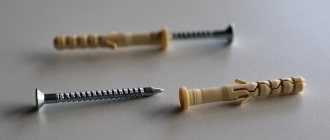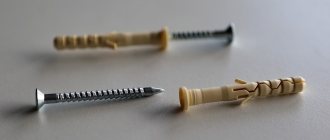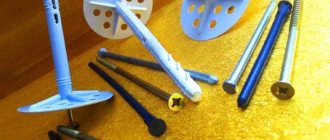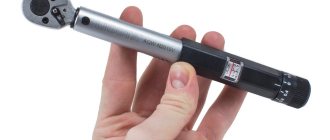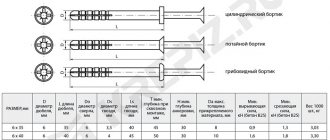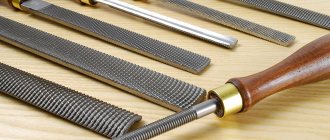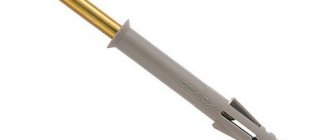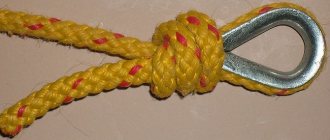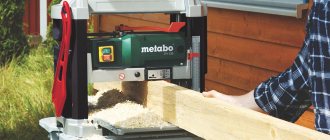The modern dowel-nail replaced wooden dowels, which often split into pieces, dried out and did not adhere well to the load-bearing surface. Composite fasteners with a spacer sleeve significantly speed up most installation work, providing the most reliable fastening of furniture and other products.
What is a dowel-nail?
There is a huge range of fasteners. You need to know what a dowel-nail looks like and understand its varieties in order to choose the best installation method for the job. In the most common version, it is a composite product of two items - a nail and a dowel. When driving the rod, the spacer part expands and is fixed in the surface. The dowel and nail can be made of different materials; more often, depending on the conditions, durable steel or plastic is used.
How to install a dowel in a wall: installation technology for drywall
The surface of the walls is often sheathed with plasterboard sheets. However, it is not always possible to install decorative elements or other structures on such a base. This is due to the fragility of the surface and its inability to withstand significant loads. Fasteners for concrete, brick and stone are not intended for plasterboard, asbestos, MDF, fiberboard or particleboard. There are special dowels for them, which mostly lack expansion. As a replacement, a two-sided crimp is used for the carrier sheet. The expansion is present only in Driva dowels.
Installing a dowel into a plasterboard surface
When deciding how to install a dowel in drywall, you should use the technology of installing fasteners on a concrete base, with the exception of some points. Holes for fasteners in drywall should be made using a drill with the impact mode turned off. Their diameter must strictly correspond to the thickness of the dowel, and the length must be 5 mm longer than the size of the screws.
If you use a self-tapping dowel, which has a kind of drill at the end, the element is screwed into the base using a screwdriver or screwdriver. However, if the thickness of the sheets is more than 15 mm, then to facilitate the work it is necessary to first make holes in them.
Before installing the butterfly dowel for drywall, a through hole is made in the surface. A fastener is inserted into it, which opens from the back side in the free space and rests against the base when a self-tapping screw is screwed into it.
Important! The self-tapping screw for the butterfly dowel must have a length of at least 55 mm, this will ensure full opening of the fastening element during installation.
The location of the dowel and self-tapping screw inside the plasterboard structure
The umbrella dowel is inserted into a pre-prepared hole and opens into the empty space after screwing in the self-tapping screw. This product is complemented by a fastening hook or ring, so it is often used when installing chandeliers.
Why do you need a dowel-nail?
The main purpose of this product is to securely attach to the load-bearing surface. A dowel-nail for concrete or brick allows you to significantly speed up the pace of work. The presence of a limiting cuff helps not to bury the cap too much into the surface. Nowadays, to fix the slats, it is not necessary to make precise markings. The holes are drilled directly into the plank and the prepared dowel-nails are driven directly through them. The slots on the caps are made to simplify the dismantling of products.
Dowel-nail - characteristics
When preparing for construction work, you need to purchase a lot of consumables. Depending on the type and size, the mounting dowel-nail has different technical characteristics. Let's consider the main parameters of this fastener (minimum and maximum data) using the example of polypropylene products with a hidden side:
- The designation of dowel-nails
is from 6x40 to 10x100. - Do
- hole for dowel (from 6 to 10 mm). - L
– dowel length (from 40 to 100 mm). - Ds
– diameter of nails (from 4 to 7 mm). - Ls
– length of nails (from 42 to 102 mm). - T
– depth of the hole for the dowel-nail for through installation (from 50 to 150 mm). - H
– anchorage depth (from 30 to 50 mm). - Da
– thickness of the attached product (from 10 to 100 mm). - The magnitude of the pulling force (for B25 concrete)
is from 1.6 to 2.4 kN. - The magnitude of the shear force (for B25 concrete)
is from 1.8 to 4.1 kN. - Weight 100 pcs.
dowel-nails - from 3.3 to 15.32 kg.
What is better, a dowel-nail or a dowel-screw?
In both cases, we have products consisting of two elements - a spacer part and a rod (nail, screw). The main difference between a dowel-nail and a dowel-screw is the method of installation in a load-bearing surface. In the first case, you need to drive a nail, and in the version with a screw, the fasteners are screwed in with an electric tool or a screwdriver. Let's consider the advantages and disadvantages of each option.
Dowel nail:
- Installation is faster.
- Suitable for installation in any solid wall except drywall.
- Due to impact loads, the risk of destruction of the front surface increases.
Dowel screw:
- Installation takes longer.
- Dismantling is easy.
- The fastening is considered more reliable.
- Less risk of damage to the façade.
What is better, a dowel-nail or a self-tapping screw?
It is wrong to compare both types of fasteners; they are designed to work in different conditions. A dowel-nail is excellent for brick, concrete, and dense foam block. Screws are recommended for plastic, chipboard or wood. In a pliable material, when screwed in, internal threads are formed that keep the product from being pulled out. If you have to work with metal, durable types of plastic or wood, it is better to use self-tapping screws with a sharp tip or drill.
Features of using dowels
When choosing a dowel, it is not enough to focus on its shape; it is also important to know what size (length, diameter) to choose. For each working surface it is necessary to select its own fasteners. The “six” dowel (6*40) is suitable for installing profile structures in cinder block houses. By choosing a different size, it will not be possible to make repairs, since all the fasteners will simply fall out of the drilled holes.
For panel houses (as well as those where there are no voids in the walls), the best option for dowels is 6*60 or 6*80. With them, everything will be securely fastened, nothing will fall through or fall out even on the ceiling.
When choosing the length of the dowel, it is worth remembering the load that the fastener will be subjected to in the future during operation. The shorter the dowel and self-tapping screw, the less load it will withstand. The diameter is also important. For ordinary housework (hanging a cabinet, mirror or wall unit), dowels with a diameter of 8-10 mm are sufficient. The only difference is the depth of the hole being drilled, since the load on the dowel is different.
For a cabinet, 3-5 cm is enough, and for a wall unit or a heavier cabinet or shelf - 8-10 cm. Another important question that arises before the master is what kind of drill is needed for the dowel. To answer this, you first need to know what surface will be drilled and what load on the structure is planned in the future after the work is completed.
Types of dowel-nails
Depending on the conditions, builders have to use different tools. For example, attaching an object to a concrete or plasterboard wall has a significant difference. In some cases, the reinforced strength of the rod is important, in other places - thermal conductivity and moisture resistance. Even a seemingly simple driven dowel-nail has several varieties, which differ not only in size and material, but also in the method of installation.
Common types of dowel nails:
- Dowel-nail for manual installation
. - Dowel-nail for a gun
- installation is carried out using an automatic device, which greatly speeds up the progress of work. It does not have a spacer part. The nail is made of the strongest steel (hardness 53-56 HRC, bending no more than 0.1 mm). - Acoustic dowel-nail
- in the manufacture of fasteners, not metal is used, but plastic and fiberglass, which prevents corrosion or the passage of cold. Consumables of this type are used for installation of thermal insulation, sound insulation, cable ducts, and decoration. - Dowel-nail “umbrella”
– has a wide head and a long body, used for fixing thermal insulation.
Plastic dowel nails
A cup made of synthetic material has a spacer and non-spacer surface. The plastic dowel-nail is equipped with a cuff that prevents the fastener from falling into the surface. The presence of toothed elements prevents the product from scrolling in the hole. We list the common types of plastic fasteners:
- Universal dowel
- used together with wood and chipboard screws, screw-screws, suitable for hollow and solid materials. - Expansion dowel S
- nylon fasteners have a double-sided expansion. The absence of a stop edge allows you to hide the dowel inside the plaster. - MS Expansion Dowel
– Suitable for use with standard bolts or threaded rods. - Dowels for aerated concrete GB
– the presence of spiral ribs allows for a very strong fit in soft materials. - Dowels for mounting TV/TVV steps
– have a good surface geometry to prevent creaking and vibration. TV brand fasteners have a small spacer for installation in a steel profile.
Metal dowel nails
The use of a steel spacer sleeve increases the cost of the estimate, but allows you to increase the design load. A metal dowel-nail for foam blocks, brick structures or concrete structures is installed in the same way as plastic fasteners. We list the advantages and disadvantages of this product:
- High load-bearing capacity.
- Metal does not stretch over time.
- The galvanized or stainless steel sleeve is resistant to corrosion.
- Large selection of fasteners.
- Easy installation.
- The cost of dowel-nails made of metal is higher.
- It must be taken into account that steel fasteners can create more stress, so it is better to place them further from the edge.
What material is the dowel plug made of?
Most fasteners are made from plastic. This is due to the low cost, availability, increased performance characteristics of the material, as well as the lack of the need to apply significant effort when screwing fasteners.
Various types of polymer materials are used for the manufacture of plastic retainers.:
- polyethylene. Easily deformable while maintaining integrity. It is lightweight and resistant to corrosion. Can be used when temperatures drop to 40 degrees below zero. Disadvantage: gradual loss of performance properties and cracking;
- polypropylene. It is used mainly indoors, as it is susceptible to negative temperatures. Advantages: increased hardness, wear resistance, and the ability to operate at high temperatures. The weak side is the appearance of cracks during long-term operation under temperature changes;
- polyamide. The material is also known as nylon. It is little subject to wear and is not afraid of mechanical stress. The nylon fastener is the most durable and reliable among other plastic fasteners.
Dowel for thermal insulation with a metal nail and thermal plug Strezzar Standard ST-M10x140 - 1
Along with plastic clamps, metal products are used :
- of stainless steel;
- galvanizing;
- alloys based on brass or bronze.
Despite the increased strength characteristics and rigidity of metal fasteners, they are inferior to plastic in their ability to deform while maintaining integrity. At the same time, the metal is able to withstand increased loads. Protective coatings significantly increase the service life of metal dowel elements.
How to choose a dowel-nail?
When purchasing consumables, you should take into account their design features. For example, a dowel-nail for insulation has an elongated body to pierce through a block of mineral wool or foam plastic, and a wide head to hold soft material. The shape of the plastic head must meet the mounting conditions. Cone-shaped “sunk” caps are recommended for window frames or wooden beams. When fixing metal brackets, a tighter fit of the cap to the plane is required. Taking into account the type of supporting base, the spacer part of the fastener is selected:
- For a solid base, where anchoring occurs due to friction, a universal dowel-nail is suitable.
- In porous blocks, anchoring is carried out due to the special shape of the sleeve. For example, dowel-nails for aerated concrete have a spiral spacer part.
Dowel-nail - dimensions
Understanding the standard sizes of this fastener is very simple. When choosing a dowel-nail for drywall, foam blocks or brick, you need to know exactly the thickness of the material being attached and the design load. The first number on the marking indicates the outer diameter of the spacer, and the second number indicates its length. For fasteners with polypropylene spacers, the following standard sizes are available:
- 6x40;
- 6x60;
- 6x80;
- 8x60;
- 8x80;
- 8x100;
- 8x120;
- 8x140;
- 10x100.
Dowel nails for an automatic gun have a smaller selection of standard sizes:
- 4.5x30;
- 4.5x40;
- 4.5x50;
- 4.5x60;
- 4.5x80;
- 5x100.
Types of fasteners
When deciding which fasteners to choose for aerated concrete - which is best for specific application conditions, it is necessary first of all to take into account the main characteristics by which they differ from each other, as well as their main varieties and properties. The most popular today are dowels, anchors and self-tapping screws. Let's look at their features in more detail.
The principle of operation of the dowel and its characteristics
The dowel for the gas block has a sleeve and a self-tapping screw in its design. The first is inserted into the drilled hole. As the screw is screwed into it, it expands along the entire perimeter. Using special elements, it tightly bites into the porous mass of concrete over a large area, thereby ensuring reliable fixation.
Expanding dowel elementsSource uniform-met.ru
Dowels differ in a number of characteristics, the main ones being:
Design and type of ribs.
Fastening elements are made in the form of a spiral or cone
Installation method.
The product may become clogged or screwed into the wall. The first option is preferable when the sleeve is placed in a through hole in the wall.
Material type.
The core is usually made of alloy steel with anti-corrosion coating. The collet can be made of metal, nylon, or plastic.
AnchorSource 1beton.info
Dowels
There are the following modifications of dowels:
Dowel-nail for aerated concrete.
The fastening mechanism is based on the opening of the sleeve as a smooth metal core is driven into it. It is universally used for any density of porous concrete.
Nylon expansion type.
Characterized by high resistance to rust. It has a small load-bearing capacity and is suitable for mounting light objects - lamps, non-load-bearing shelves, wiring, communication systems, mirrors, light interior items.
For fixing frames in window and door openings.
It can have a different base - plastic, metal, nylon. Thanks to the special design, it does not overload the gas block. Used for fixing frames, guides and other elements of windows and doors.
Steel with a protective layer of zinc.
It is characterized by maximum strength and fire resistance, but is susceptible to rusting processes. Designed for fixing heavy objects - furniture, household appliances, bathrooms. devices, guides for panel finishing, etc.
Steel dowelsSource wixstatic.com
Has maximum resistance to corrosion. Used for fastening in showers and toilets. Not intended for outdoor use due to low frost resistance.
Dowels for aerated concrete for fastening external facades.
Used for fastening steel profiles for external panel finishing.
Anchors
Fasteners for gas silicate blocks in the form of anchors differ in the following types:
Mechanical.
The fastener sleeve, inserted into a pre-drilled hole, expands widely when a bolt or stud is screwed into it. This mechanism creates reliable fixation of the anchor in the body of porous concrete.
Chemical.
The principle of preparatory procedures is similar to the mechanical analogue. However, unlike it, the voids in the concrete mass are additionally filled with a special adhesive composition, which creates a more reliable fastening.
Action of a chemical anchorSource vikbud.ua
Self-tapping screws
Fastening the sheathing to aerated concrete can be done using special self-tapping screws. The main feature of their design is a larger and wider thread than standard products. When installing them, two requirements must be met:
- The depth of penetration into the material is at least 6 cm.
- Screwing must be carried out with force control, otherwise the cutting in porous concrete may be torn off and the fasteners will be weakened.
Due to the fact that self-tapping screws for aerated concrete are screwed directly without bushings and are in direct contact with the wall material, their surface must have an anti-corrosion coating.
How to attach a dowel-nail?
Having understood the standard sizes and learned to use an impact drill and hammer drill, it is very easy to install structures using this fastener. The instructions on how to use a dowel-nail are simple:
- Mark the center of the hole.
- We use a puncher to punch a hole of the required diameter, taking into account the markings.
- The length of the hole should be 5-6 mm longer than the dowel used.
- It is advisable to clean the hole from dust with a vacuum cleaner.
- Carefully hammer in the dowel spacer cartridge with a hammer.
- We hammer in a nail, if necessary leaving 2-3 mm for attaching the suspension.
- When fixing brackets or strips, the dowel is inserted from above through the mounting hole in the product.
Dimensions and weight
For ease of use, manufacturers produce dowel fasteners in various sizes. The parameters of this product are marked with two numbers. For example, 10 by 80, as well as 30 by 6 or 8 by 160 - the first number in this case shows the diameter in millimeters, and the second number indicates the length of the dowel. The diameter of the dowel is in the range from 5 to 23 mm, as for the length, it ranges from 10 to 160 mm, although there are products with a length of 200 mm, for example, a dowel-nail 10x200 mm.
The most popular sizes for household use are considered to be fasteners 6x40, 5x50 or 5x60 mm, as well as 6x60 mm. For industrial applications, dowels measuring 8x160 mm are often used. When purchasing a dowel-nail, the consumer is faced with the fact that they are often sold by weight, and the weight of products for wholesale or small retail purchases is indicated not for 1 unit of fasteners, but for 1000 dowels.
How to remove a dowel-nail?
Often, during dismantling, the plastic part becomes firmly stuck in the surface. To pull out a dowel-nail for concrete or other material, craftsmen have invented several tricks:
- We screw the screw into the spacer cup and then use pliers to pull the product out of the wall.
- In serious cases, it is better to use a nail puller instead of pliers.
- If the tip of the screw is broken, you can melt the plastic part enough so that the exposed surface is enough to grip the pliers.
- The metal dowel-nail will first have to be loosened a little in order to be pulled out of the wall.
- If the metal part protrudes very little, then you need to use a hammer drill to make a recess around the head in order to reduce adhesion to the material and free up part of the dowel for a comfortable grip.
Rules for securing a butterfly dowel
Using the anchor is very simple, just follow the instructions for the work:
- The first step is to determine the installation location of the structure; do not forget that the kit may not include self-tapping screws and they will have to be purchased separately.
- Using a building level, the installation of fasteners is marked - the main thing is not to make a mistake, otherwise the wall will be damaged.
- You need to drill drywall with a drill whose diameter is 8 mm. Don't forget that drywall is a very malleable material, so you can use a wood drill to work with it. It is better to use a screwdriver for drilling; its power is enough for this material, especially since it is much more convenient to work with it.
Attention! When drilling a structure on a plasterboard ceiling, put a plastic cup on the drill, which will collect debris and keep the room clean
- The dowel must be grasped with your fingers and threaded through the hole made earlier, up to the head of the product. Now you can screw in the screw. After such installation, a structure is obtained that can withstand a weight of 17 kilograms.
- The fixing element is attached last, the size of which will be selected based on the thickness of the screw, for example, if the dowel is three millimeters, then a screw-in element of 3.5 mm is taken.
Option for installing drywall using a butterfly dowel
The screw must be screwed in all the way, only in this way the elements of the dowel will expand as much as possible and be securely fixed to the plasterboard wall. The work is simple and takes a minute, especially if a screwdriver is used for screwing.
The video shows how to properly attach a butterfly dowel to drywall.
I would like to note that for attaching household items to plasterboard walls, it is worth using the Butterfly dowel nail - it is an easy-to-use and reliable fastener. Choosing the right fastener is quite simple, since the range of this material from different manufacturers and from various materials on the market is large. Even professionals appreciated the practicality of using this type of fastener on plasterboard structures.
